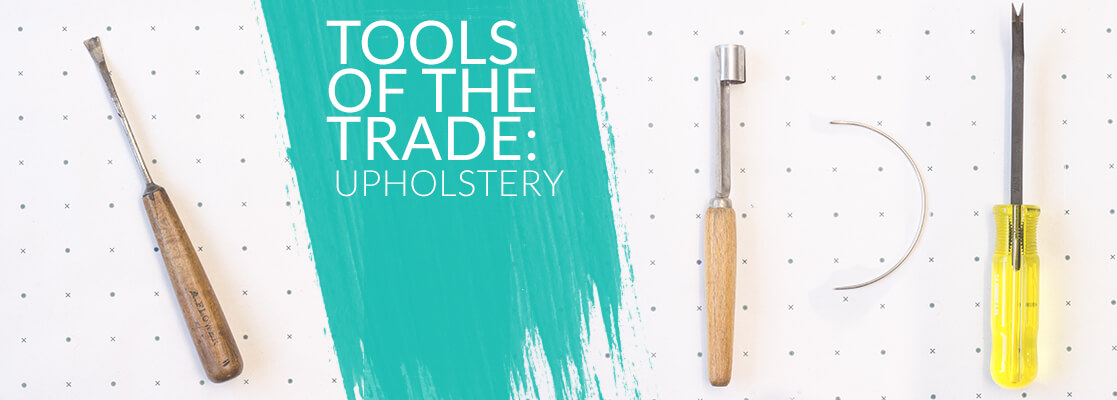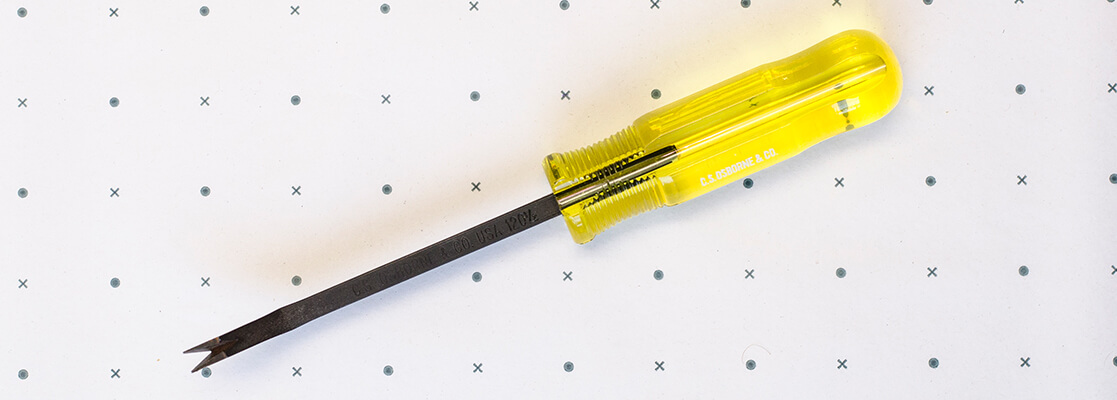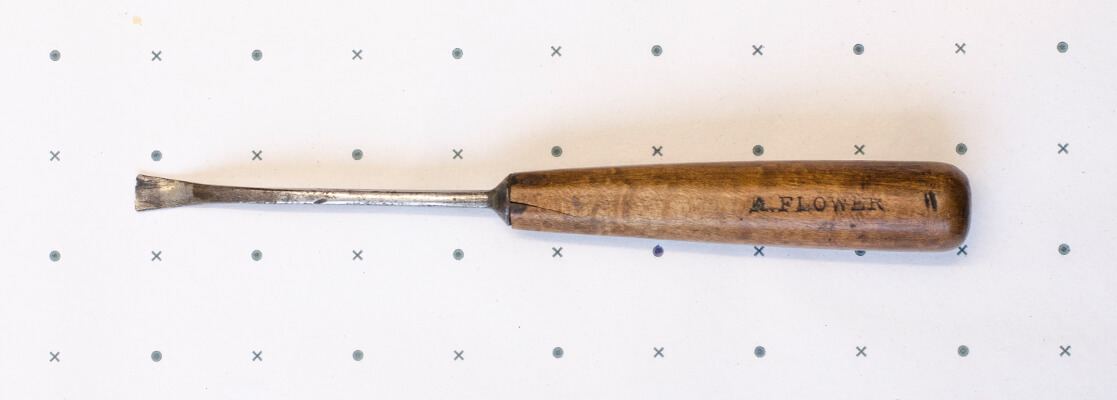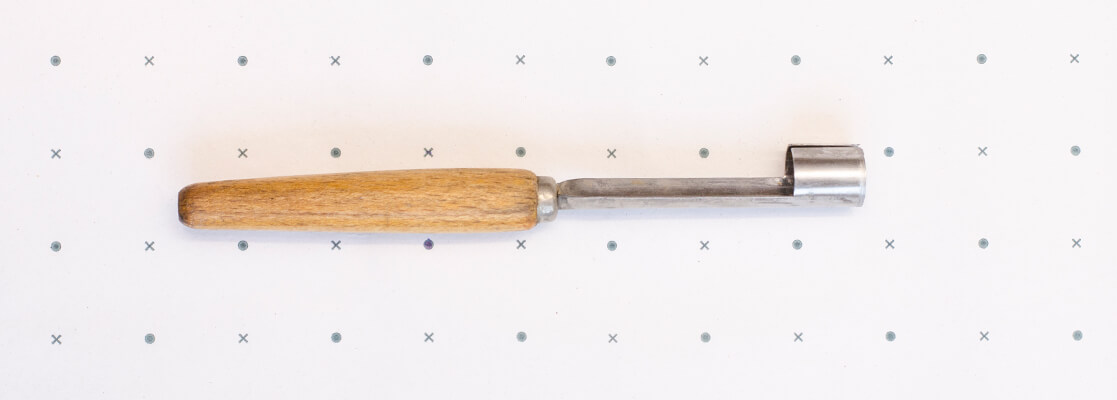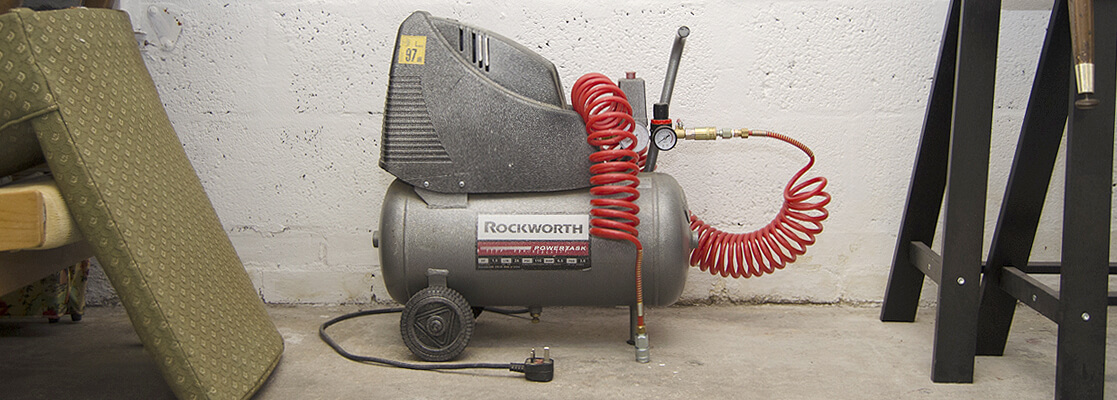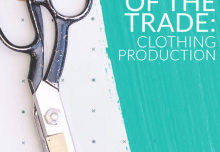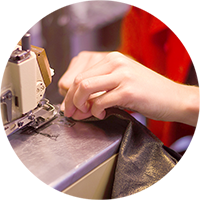In our Tools of the Trade series we’re celebrating the lovely gizmos and gadgets that help us to create wonderful clothing, effects and objects – exploring a different creative industry each time. This week our studio-mate Mel Shearsmith explains the tools she uses in her traditional upholstery.
I’m a traditional upholsterer, I re-build and re-cover chairs for customer commissions and to sell. My background as an artist and movement practitioner influenced my choice to train as a traditional upholsterer, employing traditional techniques to create unique, contemporary designs using natural materials rather than foam and man-made surrogates. This process gives me more control over building and sculpting the body of the chair.
The design of the chair and traditional techniques inform the materials I use in re-building and shaping, while considering how the covering fabric will compliment and reflect the style and character of the chair and its owner. Its function, design, comfort and aesthetic are all equal components in this process. I’m a vegetarian and have made a conscious decision not to use animal products, I supplement horse hair with coir fibre (coconut shell hair), cotton wadding and wool for ultimate comfort.
I have a particular passion for vintage and natural fabrics; wool, linen and cotton. These materials are inherently strong, naturally fire retardant (chemical free) and allow the body to breathe. The combination of natural materials and traditional techniques is instrumental in creating a chair that retains its shape, its ‘plumpness’ and lasts for decades.
Upholstery is sculpting process, it is chair sculpture.
Lizzie and Kate Antiform call it ‘chair archeology’.
Curved upholstery or mattress needle
The needle is curved to let an upholsterer get into awkward place when slip-stitching and comes in several sizes. The slip-stitch is a hidden, hand stitch that joins two fabrics together on a chair frame, usually on the outside back, outside arm or for details such as piping or arm front facing.
It is the finishing touch to completing a chair and creates more control over the line where two fabrics meet. Slip-stitching is a traditional technique used as an alternative to staple gun or metal tack strips. This process allows me to get close to the chair, be in control of the finishing touches in extreme detail. There is something about that final half an hour of intimacy with the fabric and the object that is an act of fondness and farewell.
Staple or tack lifter
This tool is a gem for getting into and removing old and stubborn staples that are embedded in the frame of a chair. It has two sharp teeth that dig in, with the help of a good tap from a wooden mallet, under the embedded staple and is slightly curved so the staples can be lifted out easily. If it’s a particularly stubborn staple carpenter pincers can be used to tweeze it from the wood.
It looks dangerous and probably is. Don’t run whilst carrying this tool nor hold it in your hand when participating in a particularly heated conversation!
Vintage carpenters carving chisel
This beautiful chisel was found at Bristol Design, on Perry Road, Bristol. The shop is a menagerie of wonderful, once adored, old tools of all shapes and sizes. I’ve spent many delighted hours in their shop ‘oohing’, crooning and yearning over their incredible selection of carpenters tools. I believe this particular chisel is originally used for gauging and shaping wood, however I’ve only used it for getting into awkward places where the tack or staple lifter cannot reach. I fell in love with it, its delicate shape and inscribed handle – A. Flower (I presume its the original owners name) – and it wouldn’t let me leave the shop without promising to take it home.
Apple corer
This is an old apple corer. It’s the kind you are sure to find in everyone’s kitchen and is used for coring apples and pears. I found it in a vintage shop on North Street in Bristol last year and purchased it for deep buttoning.
I use it for cutting out circular holes in foam. It creates the spaces for buttons to sit in when deep buttoning – when the buttons sit deep in the stuffing of a chair between indented diamond shaped folds of fabric, a decorative technique in upholstery. The traditional technique for deep buttoning is to use a regulator (a very large needle) and your fingers to create spaces in the stuffing for the buttons as an apple corer cannot cut through coir fibre (coconut shell hair), wadding or wool. The alternative to deep buttoning is called shallow buttoning, where the buttons sit on the surface of the fabric and are pulled tightly through the fabric and stuffing. Shallow buttoning doesn’t need any complicated mathematical calculations, deep buttoning does.
Air Compressor – Rockworth Rockerfella
Rockafella was snapped up at a bargain price as he already had a few years under his belt. We did test him out but unfortunately he didn’t last very long. I’ve had to sell him and recently purchased a new, super-red version.
The air compressor is used with a staple gun. It builds and contains air to a certain level to power a pneumatic staple gun. An upholsterer uses this equipment as it helps staples penetrate the wooden frame of the chair, stapling on spring ties, webbing, hessian, calico and covering fabric. Most upholsterers use a staple gun as it is faster than employing the traditional method of tacks (hammering them into the wood) so it is more time efficient and therefore financially cost effective. I prefer to work with tacks as you have greater control over placement and tacks are easier to remove for future upholsterers. I do use the gun when working on delicate frames or with vintage fabrics that can be more prone to tearing with tacks.
Follow Mel’s upholstery adventures at www.apeculiargrace.com and
Twitter – @apeculiargrace
Facebook – facebook.com/apeculiargrace
Instagram – instagram.com/apeculiargrace

